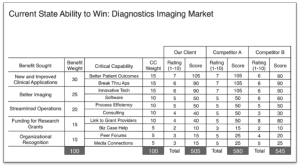Even If You’re Not Ready to Kill It, It’s Time to Demote the Old Standard

No doubt, your mother once asked you after a misstep, “If all of your friends jumped off of a bridge, would you jump too?” We would like to propose the business corollary to a common planning mistake: If all of your business colleagues use SWOT analysis, would you use SWOT too?
You already know that SWOT stands for an analysis that highlights your company or brand’s Strengths, Weaknesses, Opportunities and Threats, because – admit it – you use it in your plans as a key input to your strategy. We see enough SWOTs to know that its’ use as an overrated strategy tool is responsible for the slow growth and lack of differentiation of many brands.
That’s why we want to kill it. Or at least cut back its’ use significantly, as you will see at the end of this short article.
What’s Wrong With SWOT?
SWOT analysis is, at it’s worst, an internally-focused analysis. Time and again we see companies base their strategies on a strength that simply does not matter to its’ customers.
For example, a medical device company kept touting its superiority in educating doctors — long after doctors needed or wanted training. The company’s customers already felt they fully understood the maturing product category and were looking to fulfill other needs in this market.
SWOT is, at it’s mediocre best, a competitor-focused analysis. Companies often invest in shoring up a weakness or reacting to a competitive threat only to find that the resulting capability is not anything customers care about.
For example, the online education company that spent huge sums managing a separate process just because competitors were doing it. Called “lazy registration”, new users didn’t have to register with the site right away.
Research and actual user behavior showed customers couldn’t care less about lazy registration – the company and its competitors were wasting time and resources managing a process that just didn’t matter to customers.
SWOTs Much More Powerful Cousin
The problem with SWOT – which you’ve probably figured out by now – is that it is not a customer-focused analysis. Comparing your company against competitor’s matters only if what you are comparing, matters to customers. First find out what customer’s want, then figure out if you are strong, weak, competitively threatened or have an opportunity in those areas.
Our own Ability to Win framework provides this discipline to our clients. As you can see below, the analysis moves left to right. It starts with the benefits that customers are seeking and only then compares competitive strengths and weaknesses in those areas from the customer’s perspective.
The resulting score shows how well a segment or customer group perceives your offering fulfills their needs (see below for an example from our book, The Accidental Marketer, highlighting a company in the medical equipment market — click on the image to see the detail):

Using the customer’s perspective in the Ability to Win often paints a scary picture, especially if you are facing strong competitors and/or are not the dominant player in a market (like our client above). Maybe using a SWOT in planning seems less scary, because it starts with a long non-prioritized list of your company’s strengths.
But if you want to win, you must first face reality. And the Ability to Win gives direct guidance to where you can leverage company strengths and improve weaknesses that will matter to customers.
A Death Sentence Reprieve for SWOT Lovers
If you are one of those “bridge jumpers” that can’t bear to part with your SWOT, take heart – it has one useful purpose. A SWOT can be helpful assessing your own and competitor’s capabilities after you have assessed customer needs.
Then – if you must — you can use your SWOT as a guide to help you understand your own and competitor’s capabilities in fulfilling those needs.
But we think you are better off without it. SWOT takes you away from something that is, has been and always will be the driver of success in business – understanding and fulfilling customer needs.
For this reason, in our opinion SWOT is dead – long live the Ability to Win!

 Tom Spitale
Tom Spitale